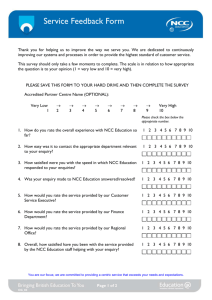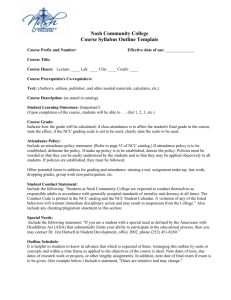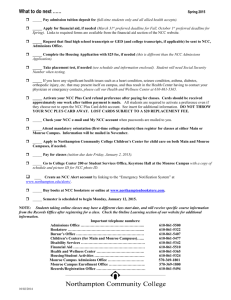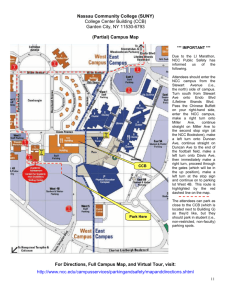competency based training for
advertisement
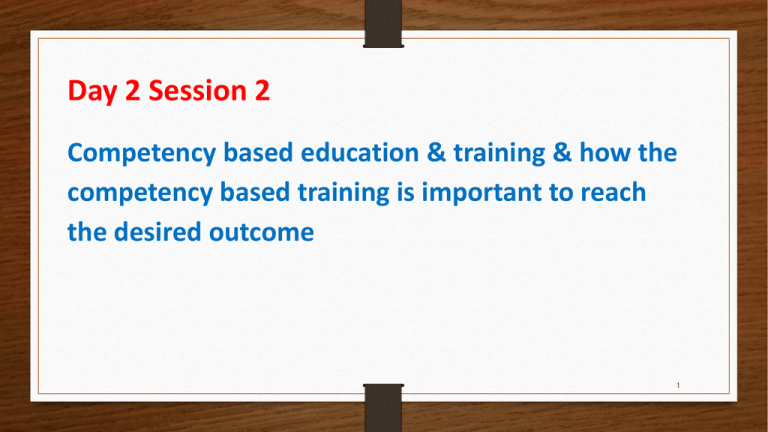
Day 2 Session 2 Competency based education & training & how the competency based training is important to reach the desired outcome 1 OUTCOME BASED EDUCATION & COMPETENCY BASED TRAINING FOR Engineering Technician------------------AGTI Engineering Technologists--------------BTech Professional Engineer--------------------BE Education Programs 2 AGTI Breadth, depth and complexity involving analysis, design, planning, execution and evaluation across a range of technical and/or management functions including development of new criteria or applications or knowledge or procedures. Applications involve significant judgement in planning, design, technical or leadership/guidance functions related to products, services, operations or procedures 3 AGTI demonstrate understanding of specialised knowledge with depth in some areas analyse, diagnose, design and execute judgements across a broad range of technical or management functions generate ideas through the analysis of information and concepts at an abstract level demonstrate a command of wide-ranging, highly specialised technical, creative or conceptual skills demonstrate accountability for personal outputs within broad parameters demonstrate accountability for personal and group outcomes within broad parameters. 4 SAMPLE COMPETENCY BASED SUBJECTS AT AGTI/BTech Equivalent Level (Advanced DiplomaEngineering-Australian Training Packages) MECHANICAL MEM30009A Contribute to the design of basic mechanical systems ELECTRICAL UEENEEG149A Provide engineering solutions to problems in complex polyphase power circuits 5 CIVIL CPCCBC6001B Apply building codes and standards to the construction process for large building projects ICT Engineering ICAPRG604A Create cloud computing services 6 Sample Performance at AGTI Level MEM30009A Contribute to the design of basic mechanical systems This unit covers contributing to basic mechanical system design, and selecting the components and mechanical features required to perform simple functions. 7 ELEMENT 1.Research equipment function and operational requirements PERFORMANCE CRITERIA 1.1. All relevant drawings, specifications, manuals and documentation are obtained in accordance with workplace procedures. 1.2. Appropriate personnel are consulted to determine requirements. 1.3. Information collected is interpreted and draft functional and operational requirements are prepared and verified with supervisor or design team. 8 2. Prepare a preliminary sketch/drawing/ specification 2.1. Appropriate components, assemblies and fasteners are selected to perform the required function. 2.2. Where required, components and/or materials are selected from supplier/manufacturer catalogues. 2.3. Appropriate and relevant codes are applied to the sketch/drawing/specification in accordance with workplace procedures. 2.4. The preliminary sketch/drawing/specification is referred to a higher authority for approval in accordance with policy and procedures. 9 3. Issue or file 3.1. Approved completed sketch/drawing/specification is sketch/drawing/s stored and catalogued in pecification list as accordance with standard required operating procedures. 3.2. Approved sketch/drawing/specification is issued in accordance with standard operating procedures. 10 Required skills Look for evidence that confirms skills in: reading and interpreting specifications and drawings Look for evidence that confirms knowledge of: relevant codes and standards basic mechanical components: shafts bearings seals fasteners, thread systems splines cams drive components: electric motors IC engines 11 lifting systems: lifting jacks hoists winch equipment pneumatic systems: advantages and disadvantages compressors pneumatic components typical circuits and applications electrical control hydraulic systems: 12 power packs pumps and other components typical circuits and applications electrical control pumps and piping system: purpose of pumps and piping systems pumps, valves, pipes and other components typical piping systems 13 Sample Performance at AGTI Level UEENEEG149A Provide engineering solutions to problems in complex polyphase power circuits This unit covers determining correct operation of complex polyphase power circuits and providing solutions as they apply to electrical power engineering work functions. It encompasses working safely, problem solving procedures, including using electrical measuring devices, applying appropriate circuit theorems and providing solutions derived from measurements and calculations and justification for such solutions 14 1 Prepare to provide engineering solutions to problems in complex polyphase power circuits. 2 Provide engineering solutions to problems in complex polyphase power circuits. 2.4 Established methods are used for solving circuit problems from measure and calculated values as they apply to complex polyphase power circuits 15 3 Complete work and document solutions for problem solving activities. REQUIRED SKILLS AND KNOWLEDGE KS01-EG149A Polyphase power circuit analysis Evidence shall show an understanding of polyphase power circuit analysis to an extent indicated by the following aspects: T1 Polyphase supply system encompassing: advantage of three phase system compared to single phase systems double subscript notation phase sequence 120 degree operator given circuit component parameters, solve practically based problems using: 16 equivalent circuits of transformers, lines and loads. component values using rectangular and polar notation. current divider and potential divider rules using complex impedances. The “per unit” values of voltage, current, VA and impedance to a common VA base. 17 T2Types of three phase system connections encompassing: supply to balanced star, 3 and 4 wire loads supply to delta connected loads effects of phase reversal representation of currents and voltages as complex phasors for 3 phase and 3 phase and neutral quantities. calculation the values of and draw labeled phasor diagrams, not to scale, to represent complex values of current and voltage for balanced and unbalanced loads for star and delta systems. 18 calculation of values of P, Q and S for balanced and unbalanced systems. draw and label single phase diagrams to represent 1 phase of a complex 3 phase system. represent unbalanced voltages or currents as symmetrical components. Phase to phase currents Phase to neutral/earth currents. 19 T3 Balanced three phase loads encompassing: calculations of balanced loads connected in star calculations of balanced loads connected in delta calculation of steady state values of fault current for various configurations. evaluation of the symmetrical component impedances for the various distribution system components. Transformers (earthed neutral case). Generators (high impedance earth) 20 calculation of fault currents using the per unit approach. calculation using the “worst case” values based on transformer impedance only (ie., a short circuit fault) estimation of peak values using accepted multipliers. effects of the d.c. component on the instantaneous magnitudes of fault currents in transformers and generators. 21 T4 Unbalanced three phase loads encompassing: Star – 4 wire systems Delta systems Star – 3 wire systems Star 4 wire with neutral impedance 22 T7 Fault currents encompassing: symmetrical components positive, negative and zero sequence impedance fault current breaking and let-through energy capacities of circuit breakers, fuses importance of fault/arc impedance calculation of fault currents - phase-to-earth faults calculation of fault currents - phase-to-phase faults analysis of asymmetrical faults currents. 23 T8 Harmonics in three phase systems encompassing: presence of triple in harmonics in 3 phase systems effects of 3 phase harmonics for different star and delta connections. methods for reducing harmonics in three phase systems 24 CPCCBC6001B Apply building codes and standards to the construction process for large building projects This unit of competency specifies the outcomes required to access, interpret and apply relevant building codes and standards applicable to the construction processes of large, high rise and complex buildings (open licensing classification with special reference to Type A buildings). 25 To successfully comply with relevant standards and codes in large constructions requires a thorough knowledge of the purpose of the National Construction Code (NCC) coupled with the ability to interpret specific standards in relation to the design and specifications of building projects 26 1 Access and interpret relevant code and standard requirements. 1.1 1.2 1.3 Relevant clauses from the NCC that apply to individual projects (classified as open) are identified. Prescriptive requirements of relevant NCC clauses for standard construction are determined for the scope of work. Requirements of relevant Australian standards referenced in the NCC are accessed and interpreted appropriately. 27 2 Classify buildings. 2.1 Nature of a building is determined according to use and arrangement. 2.2 NCC criteria to determine the defined classification are applied. 2.3 NCC requirements for multiple classifications are identified and interpreted. 28 3 Analyse and 3.1 apply a range of solutions to a construction 3.2 problem for compliance with the NCC. 3.3 Range of criteria that will ensure construction methods comply with intent of the NCC is determined. Alternative solutions to a construction problem that will comply with NCC performance requirements are discussed and proposed according to company policies and procedures and standard specifications. Performance-based solutions are identified and documented according to NCC requirements. 29 3.4 3.5 3.6 Assessment methods used by authorities to determine whether a building solution complies with the NCC are analysed and applied. NCC assessment methods are identified as appropriate to meet DTS provisions of NCC. Relevant documentation is identified and completed according to performance requirements of the NCC. 30 4 Apply fire 4.1 protection requirements . 4.2 4.3 Fire resistance required for the construction of all classes and types of buildings is determined. NCC requirements with respect to passive and active fire protection to all classes and types of buildings are identified and applied. Check of existing buildings for compliance with passive and active fire protection requirements is carried out according to NCC requirements. 31 5 Implement 5.1 strategy to manage compliance with NCC 5.2 for large, complex and high rise 5.3 buildings. Processes are established and implemented to coordinate the work of professionals involved in the development and management of the building process. Effective design solutions for buildings of more than three storeys are sought to meet the needs of clients and ensure compliance with NCC. Quality assurance processes are designed and implemented to ensure effective and compliant management of the construction process. 32 Required skills for this unit are: accurate application of building codes and standards application of design concepts and principles according to Australian standards application of design concepts and principles according to NCC analysis and interpretation skills relating to documentation from a wide range of sources, including NCC and Australian standards 33 communication skills to: enable clear and direct communication, using questioning to identify and confirm requirements, share information, listen and understand discuss and propose alternative solutions read and interpret specifications and drawings use and interpret non-verbal communication use language and concepts appropriate to cultural differences written skills to complete documentation according to NCC requirements numeracy skills to apply mathematical information included in building codes and standards. 34 Required knowledge for this unit is: application of NCC, namely: low rise: Class 1 and 10 Class 2 to 9 with a gross floor area not exceeding 2000 square metres, not including Type A or Type B construction 35 medium rise: Class 1 and 10 Class 2 to 9 to a maximum of 3 storeys, not including Type A construction open: all classes of building and types of construction application of relevant Australian standards definitions and common technical terms or usage specified under general provisions of NCC 36 design principles and the behaviour of structures under stress, strain, compression, bending or combined actions nature of materials and effects of performance NCC performance hierarchy relevant legislative and OHS requirements, codes and practices work drawings and specifications 37 Assessment of essential underpinning knowledge will usually be conducted in an off-site context. Resource implications for assessment include: NCC, Class 2 to 9 buildings and Guide to NCC documentation, including design brief drawings, specifications, codes, design concepts, construction schedules and other necessary supporting documents research resources, including product information and data access to relevant legislation, regulations and codes of practice; like NCC, National Timber Framing Code, AS1684, AS4055 and other Australian standards required to meet the purpose of intended use relevant computer software package and suitable hardware. 38 Assessment methods must: satisfy the endorsed Assessment Guidelines of the Construction, Plumbing and Services Training Package include direct observation of tasks in real or simulated work conditions, with questioning to confirm the ability to consistently identify and correctly interpret the essential underpinning knowledge required for practical application reinforce the integration of employability skills with workplace tasks and job roles confirm that competency is verified and able to be transferred to other circumstances and environments. Validity and sufficiency of evidence 39 ICAPRG604A Create cloud computing services Unit Descriptor This unit describes the performance outcomes, skills and knowledge required to design, build, test and deploy web services and cloud computing applications to specification. Application of the Unit This unit applies to those required to create and install web services and cloud computing applications in their job as a computer programmer. 40 1. Design web service or cloud computing application 2. Build web service 1.1. Gather requirements for the web service or cloud computing application 1.2. Determine the development environment and tools to create web service or cloud computing application 1.3. Identify any possible big data applications 1.4. Define architecture, framework and protocols 2.1. Itemise required functionality 2.2. Build web service in the determined environment to meet required functionality 41 3. Build cloud computing application 4. Test web service or cloud computing application 3.1. Determine required functionality 3.2. Build cloud computing application in the determined environment to meet the required functionality 4.1. Test web service or cloud computing application for overall functionality according to requirements 4.2. Iterate design or build until test results meet requirements 42 5. Deploy web 5.1. Deploy web service or cloud computing service or cloud application to the specified environment computing application 5.2. Publish web service or cloud computing application to the specified environment 43 analytical skills to: examine and define system requirements review requirements and determine appropriate solution communication skills to: interact with developer to determine system requirements interact with end user or client to determine system requirements literacy skills to read technical specifications planning and organisational skills to perform tasks according to the project plan 44 problem-solving skills to: address common problems in operating a web service or cloud computing application perform basic debugging, such as defining simple problem, locating source of the problem, and providing solution to problem research skills to find and evaluate technologies to meet system requirements 45 technical skills to: access databases and manipulate data create applications using basic programming techniques create web pages using hypertext markup language (HTML) and cascading style sheet (CSS) perform basic operations within a web environment use an integrated development environment (IDE) 46 Required knowledge development tools to produce services deployable from the internet (cloud computing) internet infrastructure object-oriented programming overview knowledge of: database access and manipulation HTML eXtensible markup language (XML) 47 B Tech The self-directed development and achievement of broad and specialised areas of knowledge and skills, building on prior knowledge and skills. Substantial breadth and complexity involving the initiation, analysis, design, planning, execution and evaluation of technical and management functions in highly varied and highly specialised contexts. 48 Applications involve making significant, high-level, independent judgements in major broad or planning, design, operational, technical and management functions in highly varied and specialised contexts. They may include responsibility and broad-ranging accountability for the structure, management and output of the work or functions of others. The degree of emphasis on breadth, as opposed to depth, of knowledge and skills may vary between qualifications granted at this level. 49 Demonstrate the self-directed development and achievement of broad and specialised areas of knowledge and skills, building on prior knowledge and skills. Initiate, analyse, design, plan, execute and evaluate major broad or technical and management functions in highly varied and highly specialised contexts. Generate and evaluate ideas through the analysis of information and concepts at an abstract level. Demonstrate a command of wide-ranging, highly specialised technical, creative or conceptual skills in complex contexts. Demonstrate responsibility and broad-ranging accountability for the structure, management and output of the work or functions of others. 50 BE The self-directed development and achievement of broad and specialised areas of knowledge and skills, building on prior knowledge and skills. Substantial breadth, depth and complexity involving the initiation, analysis, design, planning, execution and evaluation of major functions, both broad and highly specialised, in highly varied and highly specialised contexts. Further specialisation within a systematic and coherent body of knowledge. 51 Applications involve making high-level, fully independent, complex judgements in broad planning, design, operational, technical and management functions in highly varied and highly specialised contexts. They may include full responsibility and accountability for all aspects of work and functions of others, including planning, budgeting and strategy development. The degree of emphasis on breadth, as opposed to depth, of knowledge and skills may vary between qualifications granted at this level. 52 Distinguishing features of learning outcomes Demonstrate the self-directed development and achievement of broad and highly specialised areas of knowledge and skills, building on prior knowledge and skills. Initiate, analyse, design, plan, execute and evaluate major functions, both broad and within highly varied and highly specialised contexts. Generate and evaluate complex ideas through the analysis of information and concepts at an abstract level. . 53 Demonstrate an expert command of wide-ranging, highly specialised, technical, creative or conceptual skills in complex and highly specialised or varied contexts. Demonstrate full responsibility and accountability for personal outputs. Demonstrate full responsibility and accountability for all aspects of the work or functions of others, including planning, budgeting and strategy 54 Common Year 3 1. BAE 401 Advanced Engineering Mathematics (9 pt) 2. BAE 402 Calculus (3 pt) 3. BAE 403 Engineering Mechanics (1 pt) 4. BAE 404 Engineering Materials & Thermodynamics (3 pt) 5. RE001- Foundation Studies in Renewable Energy and Sustainability (2 pt) 6. .RE003- Solar and Thermal Energy Systems (2 pt) 7. RE004- Energy Storage Systems (2 pt) 8. RE005- Renewable Energy Resource Analysis (2 pt) 9. RE006- Wind Energy Conversion Systems (2 pt) 10. RE010-Engineering Materials (2 pt) 11. RE012a-Electrical Engineering Part 1 (2pt) 12. RE016-Design& Management (BAE508) (2 pt) 55 (Electrical) YEAR 4 (Specialized) 1. BAE 601 Computer Programming 2. BAE 602 Computer Network 3. BAE 603 Software Engineering 4. RE012b-Electrical Engineering Part 2 5. RE002- Grid Connected Photovoltaic Power Systems 6. RE013-Electrical Machines 7. RE014-Electronics Control 8. RE015-Electrical Project/ Practice 9. BAE 501 Advanced Power Systems & Power Transmission Networks 10. BAE 506 Power System Stability & Protection 11. BAE 604 Telecommunication Engineering 12. RE007- Energy System Efficiency 56 CIVIL Year 4 1 RE011a-Civil& Mechanical Engineering Part 1 (2 pt) (Assessment- Study Report) 2 RE011b-Civil& Mechanical Engineering Part 2a (2 pt) (Assessment- Study Report) 3 BAE 606 Building Service Electrical & Mechanical Engineering (2 pt) 4BAE421 Building Construction Engineering ( 2 pt) 5 BAE422 Estimating ( 2 pt) 6 BAE423 Fluid Mechanics ( 2 pt) 7 BAE424 Reinforced Concrete ( 2 pt) 8 BAE522 Rock Mechanics ( 2 pt ) 9 BAE 523A Environmental Engineering (2 pt) 10BAE621 Structural Engineering ( 2 pt ) 11BAE623 Surveying & Traffic Engineering ( 2 pt) 12BAE624 Water Supply , Sanitation & Finishing ( 2 pt ) 57 MECHANICAL YEAR 4 1. RE011a-Civil & Mechanical Engineering Part 1 ( 2 pt) (Assessment- Study Report) 2. RE011b-Civil & Mechanical Engineering Part 2a ( 2 pt) (Assessment- Study Report) 3. BAE 606 Building Service Electrical & Mechanical Engineering ( 2 pt) 4. BAE311 Plant Engineering (2 pt) 5. BAE314 Mechanical Power Generation (2 pt) 6. BAE315 Materials Engineering (2 pt) Part 1 Part 2 ( 2 pt) 7. BAE511 Air-conditioning & Refrigeration Part 1 ( 2 pt) 8.BAE512 Building Service Water Supply System ( 2 pt) 9.BAE613 Mechanical Instrumentation Process( 2 pt) 10.BAE614 Machine Design ( 2 pt) 11.RE007- Energy System Efficiency( 2 pt) 12.BAE 601 Computer Programming( 2 pt) 58 Commmon Graduating Units (Year 5) 13. BAE 605 Engineering Management (4 pt) 14. BAE 608 Engineering Competency Demonstration Report PLUS Other specialist elective subjects 59 BE(Electrical Engineering) Renewable Energy/ Electrical/Mechanical / Civil Engineering Principle/Computer/ Mathematics/ Design/ Management/ Instrumentation /Engineering Practice/ Ethics with Electrical Power & Electronics major BE (Civil Engineering) Renewable Energy/ Electrical/Mechanical / Civil Engineering Principle/Computer/ Mathematics/ Design/ Management/ Instrumentation /Engineering Practice/ Ethics with Mechanical Engineering major BE (Mechanical Engineering) Renewable Energy/ Electrical/Mechanical / Civil Engineering Principle/Computer/ Mathematics/ Design/ Management/ Engineering Practice/ Ethics with Civil & Structural Engineering major 60 Sample Programme Objectives. http://www.highlightcomputer.com/objectives.htm Click HERE 61 EXAMPLE DETAILED CONTENTS Certificate to Advanced Diploma http://www.highlightcomputer.com/detailedcontent.htm Bachelor degrees equivalent level http://highlightcomputer.com/B%20E+B%20App%20Sc(IT)+B%20B us%20Course%20Detailed%20Contents.htm Click HERE 62
